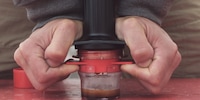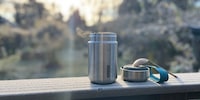

3-week test: The camping kitchen for travelling
Three weeks camping with a motorhome. A challenge for a passionate amateur chef. That's why I packed and tested an extra hotplate in the form of a gas barbecue and a camping pan set just in case.
Three weeks camping in Sweden. Or rather: glamping. Because this summer, I travelled around and across southern Sweden with my family in a motorhome rather than a tent. Even though a motorhome is a lot more comfortable than a tent, I planned exactly what I was going to take with me. At the top of my list of priorities were suitable cooking utensils. The campervan's cooker had three hotplates, all quite small and close together. Despite this, there was no room for large pans on it or in the limited storage space.
So what I needed: a stackable pan set like the one from Campo Libre and an additional, larger hob, a.k.a. a gas barbecue like the one from Campinggaz:
The camping pan set
I spent three weeks cooking for three people with the «Enzo» pan set from Campo Libre. It is the latest set from the German outdoor equipment manufacturer and was recommended to me by our outdoor specialists when I was shopping. The set contains:
- 1 cooking pot with a volume of 3.2 litres
- 1 saucepan 1.9 litre capacity
- 1 frying pan 21 cm diameter
- 1 kettle 1 litre capacity with tea strainer
- 1 lid suitable for all three pans/pots


The two cooking pots
To be precise, I cannot fill the cooking pots to more than the maximum of 2.5 or 1.5 litres marked on the inside walls. I use the larger pot to cook just enough pasta to fill three people with a reasonably well-filled plate. On the other hand, the volume of the smaller one is enough for a decent tomato sauce. I can also blanch vegetables for three people as a side dish pretty much without splatter or hassle - but the cauliflower shouldn't be too big, otherwise I won't be able to avoid cooking it in two stages.

The real problem with the large pot, however, is the handles on the sides, which are too small. They get so hot when cooking that I can only grip them with oven mitts (or an improvised alternative). It gets even worse when I want to use the perforated lid on one side as a colander: it is just as hot - or gets hot very quickly from the steam - and I have to hold it with both hands so that it doesn't slosh towards me along with the contents of the pot. A difficult task, especially as the few tiny holes in the lid are far too small for 2.5 litres of boiling water.

The handle of the smaller pot is much cleverer, as it consists of two fold-out wire arches that I can easily hold even after cooking because I folded it out before cooking.
The frying pan
The frying pan has the largest surface area. It can also fry meat, fish or fried eggs satisfactorily. However, 21 centimetres in diameter is not that much for a frying pan. Three fried eggs still fit in without any problems. But three pieces of meat, fish or sausages won't quite. Some pieces are always pushed up the side of the pan and don't get an even amount of heat. The frying pan is practical and large enough for two people, but with three eaters it gets tight.
The handle is another system of its own: when stowed away, it is folded under the base of the pan. I'm sure I won't forget it when I'm handling the pan. When folded up, it is easy to lock in place and doesn't get too hot.
The kettle
I didn't want to take the kettle with me at first. But as it doesn't need any more space anyway, I took it with me and tested it together with a camping French press. You can read the report here.
Conclusion
On our three-burner gas hob in the motorhome, there was barely enough space to use two saucepans and a frying pan at the same time. The risk of spilling something or burning yourself on the hot pans was pretty high. I cooked exclusively with this set for three weeks and the two pots and the frying pan were enough for three people. The set was particularly practical because it could be stored in an extremely space-saving way. In terms of cooking suitability, however, I would have liked more surface area as well as heat-resistant and easier-to-handle handles. A lid that fits on three different pots may be practical. But it's only one lid, leaving two pots uncovered.
The gas barbecue
The Party Grill 400 CV from Campinggaz consists of twelve individual parts when it is delivered. Three are the loose feet and two are the handles for the lid/wok that need to be fitted. Once these are assembled, I get the following:
- 1 grill tray with gas connection and water ring
- 1 hotplate for pans
- 1 grill grid
- 1 reversible grill plate, one side grooved, one side flat
- 1 lid that can be used as a wok/pan


I had to buy the gas cartridge separately, a lighter is built into the grill tray. The barbecue comes in a black carrying bag with a handle, which can easily accommodate the compact barbecue as well as one or two gas cartridges. I didn't try out all the options offered by the barbecue in the three weeks - but I will do so on other occasions.
Like the cooking set, the camping barbecue can also be packed away compactly. The grill tray and wok form the outer casing, in which all the other elements fit securely. I always stowed the barbecue in the outside storage space of the campervan.
Grill grid and plate
The barbecue has three different surfaces: the grill grate and a grill plate that can be used on both sides. One side is flat, the other grooved. I tried all three options for meat, fish and vegetables.
An argument against the grill is that the food sticks to it quite quickly. Fat and oil also drip down easily. Although some of it is collected in the grill's water-filled drip tray and can be disposed of in this way, some of it also ignites due to the high heat and can char the food and cause a lot of smoke.

The difference between the grooved and flat plate is not very big. Both sides are non-stick - so I only need very small amounts of fat or oil at most - and transfer the heat from the gas flame quickly and directly.

Personally, I just prefer it when the entire surface of the food is placed directly on the heat and is therefore cooked more evenly. I'm happy to forgo the grill grate patterns celebrated in advertising for more grill flavour. I read somewhere that I could even bake pizza on the grill plate. I'll try that out when I get the chance. On a trip to Sweden, a pizza would have been somehow sacrilegious.
Cooking plate
In principle, I could have used the grill as an additional, or larger, hob. All the components of the Campo Libre set would fit on the hob. However, the only thing I cooked on it once, as on a conventional hob, was two cups of coffee with my Bialetti coffee maker, which I have been using for many years.
Wok
I never used the Campinggaz lidded wok in three weeks in Sweden. Instead, I used it at home to make a quick vegetable and tofu stir-fry. This worked just as well as with my cast iron wok. However, the grill wok is much lighter and the heat tends to stay at the bottom and spread a little less up the sides. But that doesn't bother me in this case.
Conclusion
The Party Grill 400 CV is fun. It packs away compactly and fits easily into a motorhome or a well-packed car. And you can also transport the barbecue effortlessly in a cargo trailer for your bike. Cooking, barbecuing, baking - it's versatile and if you can manage with just one heat source, you'll love it. The various individual parts can also be cleaned quickly and efficiently. I would do without a barbecue when travelling in a motorhome because I have the kitchen with me. For camping holidays in a tent, however, I would always pack it as my go-to cooking appliance.
Globetrotter, hiker, wok world champion (not in the ice channel), word acrobat and photo enthusiast.



